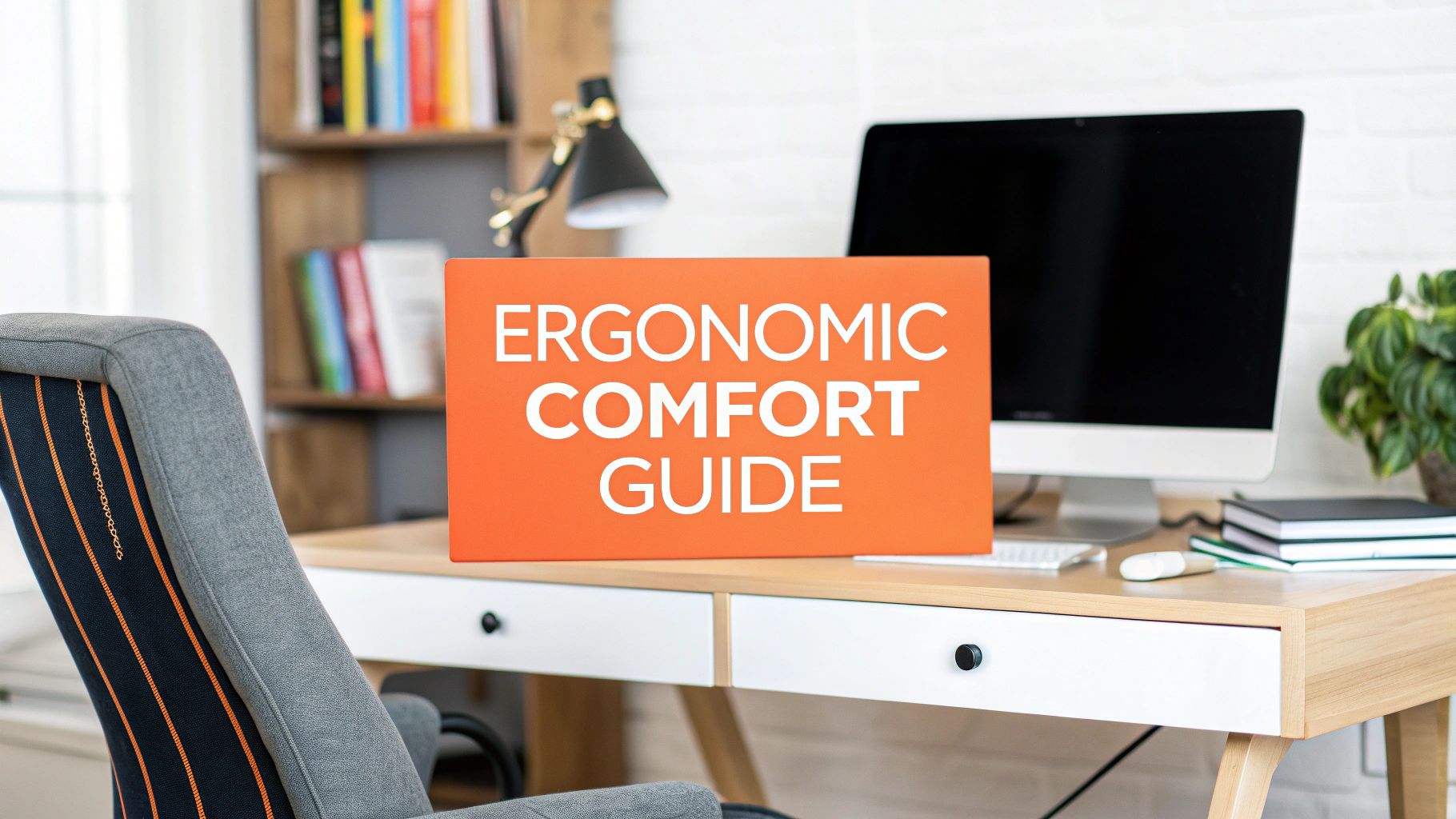An ergonomic chair is much more than just a place to sit. It’s a highly adjustable tool designed to fit your body, support your posture, and reduce the physical stress of sitting for long periods.
Think of it this way: it’s the difference between a one-size-fits-all t-shirt and a properly tailored suit. One might get the job done, but the other feels like it was made just for you.
Beyond the Buzzword: What Is an Ergonomic Chair?
So, what really makes a chair "ergonomic"? At its core, it’s a chair engineered to work with the natural curves and movements of your body, not against them. While a standard office chair offers very little adjustment, a true ergonomic chair comes with a whole suite of customisable features to support you properly through a long workday.
Taking your seating seriously is crucial for your long-term health. In Australia, musculoskeletal disorders (MSDs) are a massive issue, accounting for over 40% of all serious workers' compensation claims. The good news is that introducing proper ergonomic solutions, like the right chair, is a proven way to help. It can even cut down MSD-related absenteeism by up to 25%. You can dig deeper into this with the latest market research on ergonomic solutions.
Standard Chair vs. Ergonomic Chair
The fundamental difference comes down to one word: adaptability. A standard chair is mostly static, forcing your body to conform to its fixed shape. An ergonomic chair, on the other hand, is designed to adapt to you.
To make this crystal clear, let's break down the key differences side-by-side.
Standard Office Chair vs Ergonomic Chair at a Glance
As you can see, the ergonomic chair offers a completely different level of customisation, allowing you to fine-tune it to your specific body shape and needs.
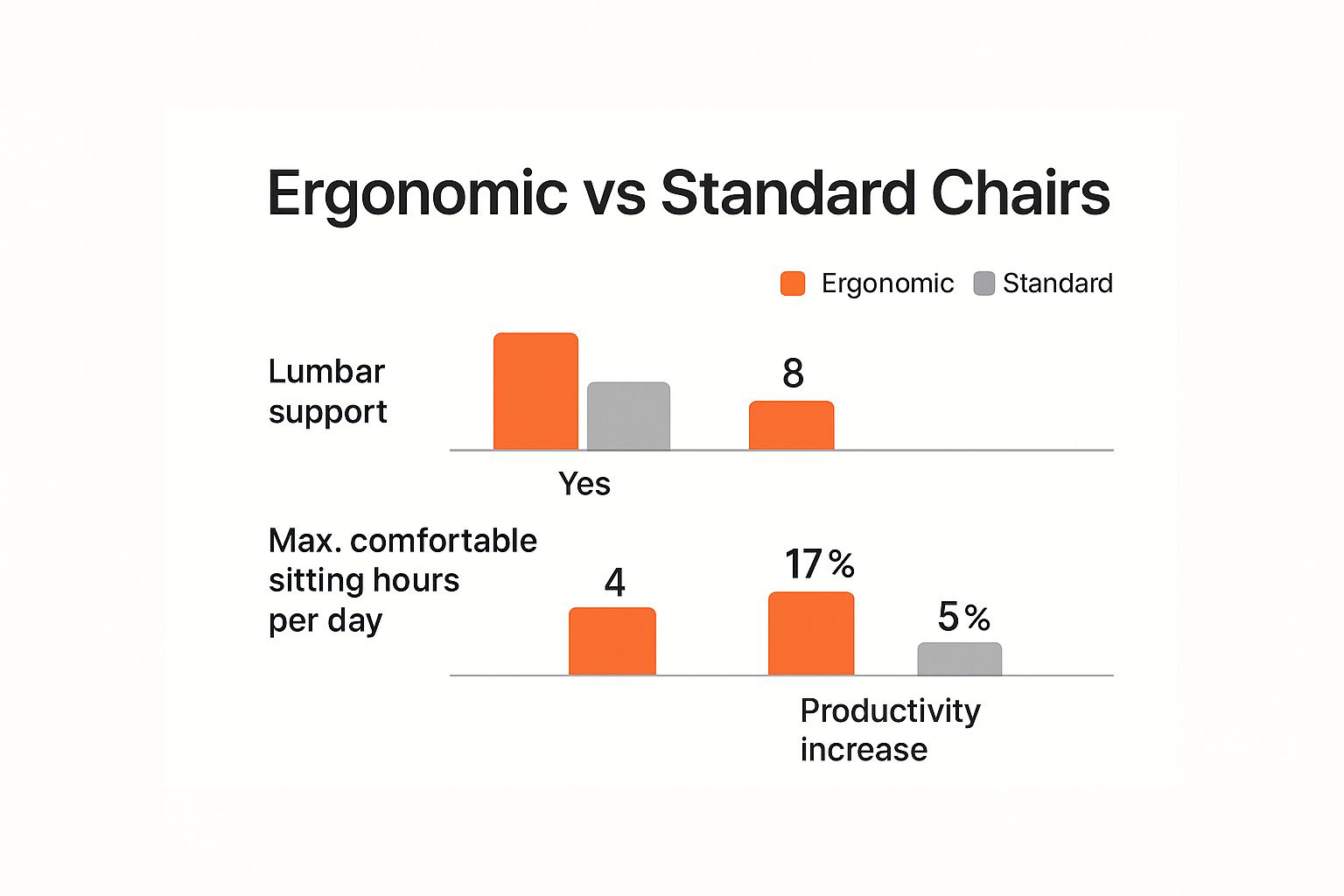
The data speaks for itself. A proper ergonomic chair can double your comfortable sitting time, which often leads to a noticeable boost in productivity simply because you are not constantly distracted by aches and pains.
An ergonomic chair isn't a luxury; it's a fundamental piece of equipment for anyone who works at a desk. It provides the personalised support you need to stay focused, comfortable, and well, day in and day out.
Ultimately, choosing a quality ergonomic chair, like a Pago chair from Officeworks, is an investment in your health and your work. For an even wider selection, the models available directly from Pago International offer a range of options to help you find that perfect fit.
The Real Benefits for Your Health and Focus
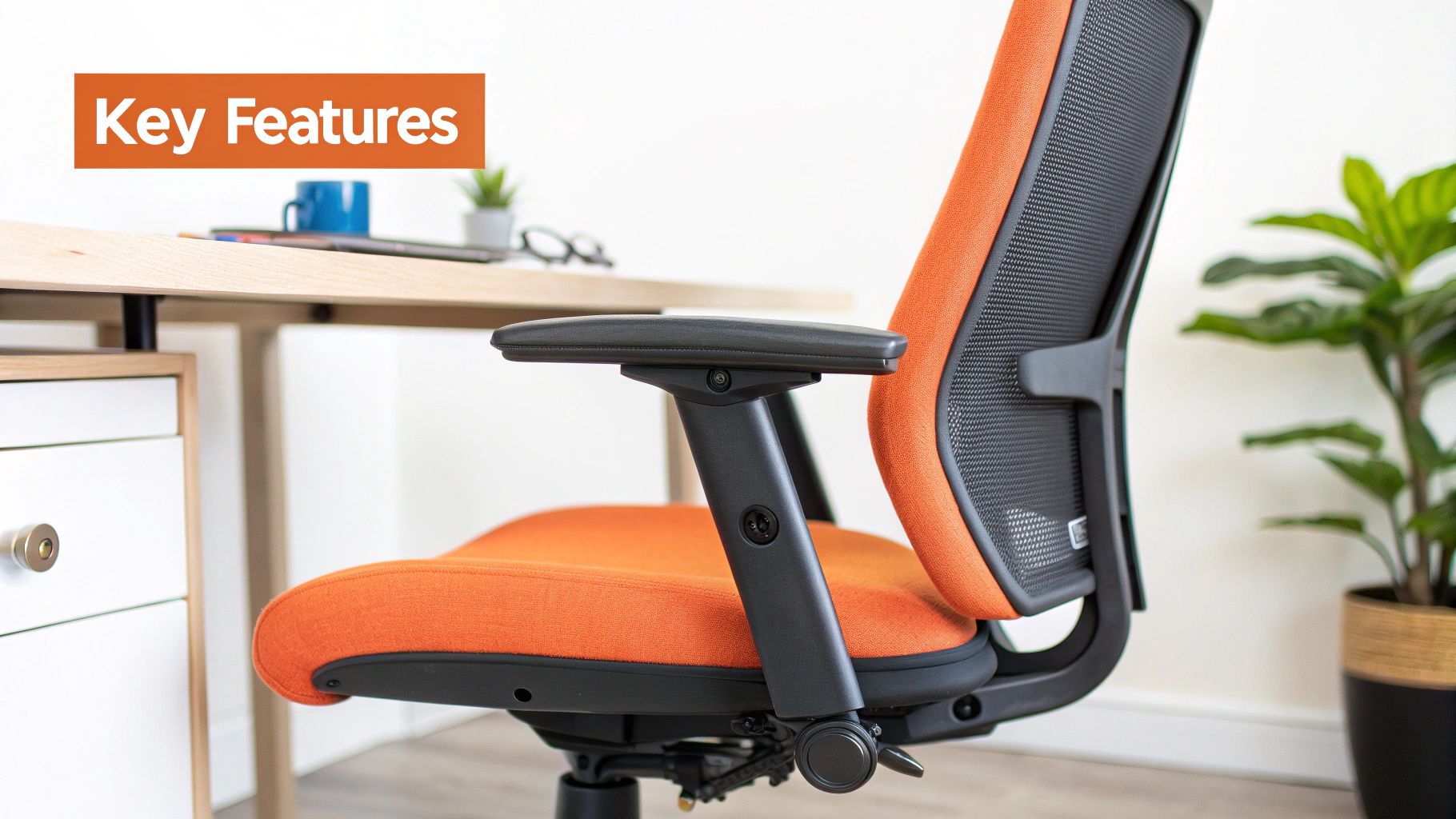
The benefits of a genuinely ergonomic chair go so much deeper than just feeling comfortable. We’re talking about tangible results for your physical health and mental clarity. A good chair actively supports your body and stops that slow, creeping strain from setting in after hours at a desk.
Think about your spine for a second. When you slouch, you're putting a huge amount of pressure on your lower back. A proper ergonomic chair has adjustable lumbar support designed to perfectly match the natural curve of your spine, taking that pressure right off.
Ever had your legs feel tingly or numb after a long sitting session? That's often from a sharp seat edge digging in and restricting circulation. This is where a waterfall seat edge comes in. Its soft, rounded front lets blood flow freely, keeping you comfortable and alert for much longer.
Linking Physical Support to Mental Performance
It’s no secret that physical discomfort is a major distraction. When you’re constantly fidgeting to ease an aching back or shifting to wake up your legs, you cannot possibly give your full attention to the task at hand. Your brain is busy dealing with the discomfort.
A well-designed ergonomic chair works by taking away those physical distractions. When your body is properly supported, your mind is free to concentrate, helping you stay in the zone and get more done.
This isn't just about feeling good. It’s about creating an environment where you can actually perform at your best, day in and day out. The right support reduces fatigue and sharpens your focus.
- Reduced Pain and Discomfort: Proper alignment from adjustable features is your best defence against common issues like neck and back pain.
- Improved Posture: The chair gently guides you into a healthier sitting position, which over time helps your body maintain it naturally.
- Enhanced Focus: With fewer aches and pains nagging you, your ability to concentrate on complex work improves dramatically.
This holistic support system even looks after your arms and shoulders. Adjustable armrests are crucial for preventing repetitive strain injuries. You can learn more by checking out our tips to relieve wrist pain from typing.
Ultimately, when you ask, "what is an ergonomic chair?", the answer is simple. It's a tool that protects your long-term health while helping you perform better right now.
The Must-Have Features of a Great Ergonomic Chair
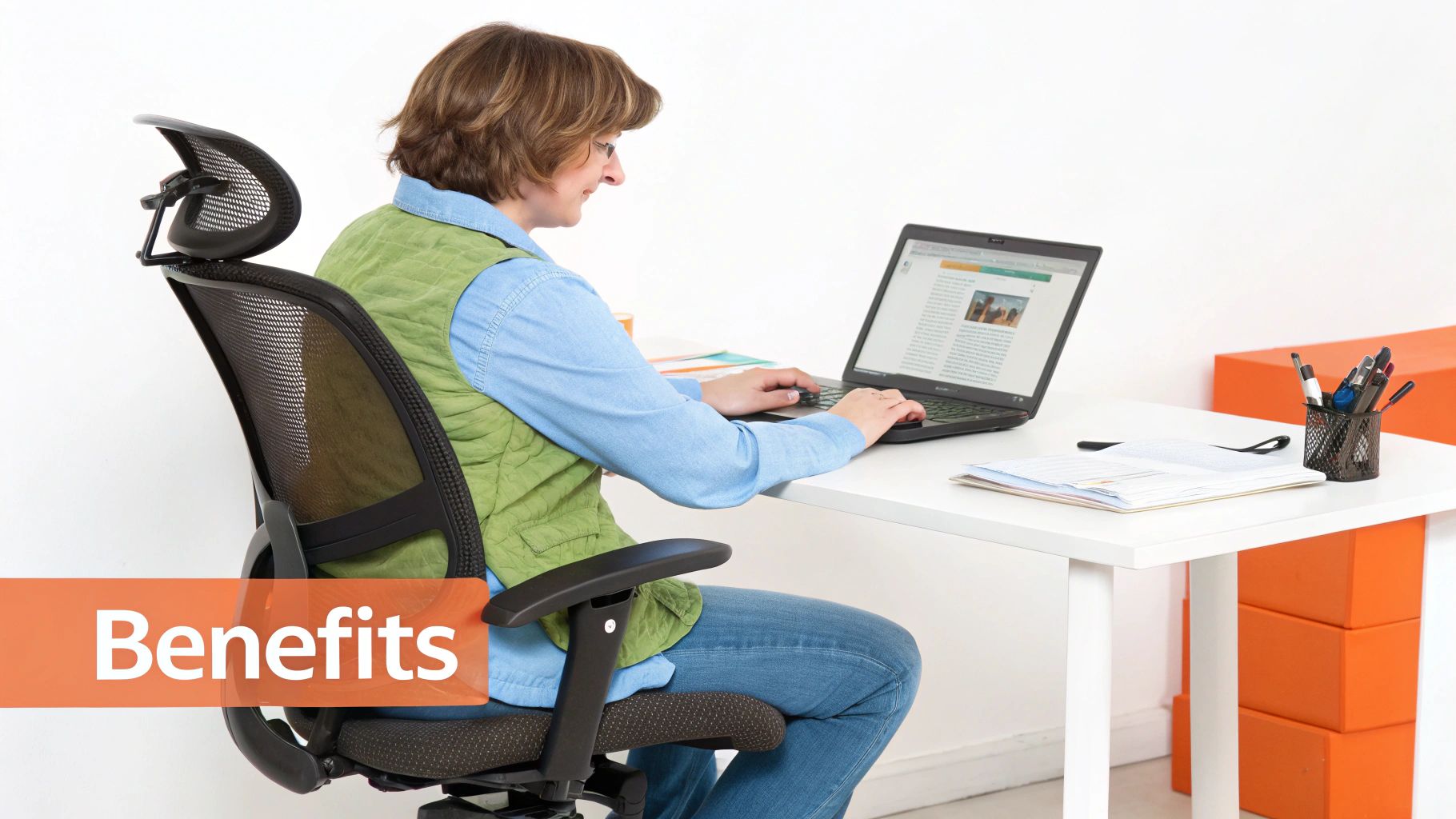
The term "ergonomic" gets thrown around a lot these days, but a truly great ergonomic chair isn't about a label—it's about adjustability. The secret is being able to mould the chair to your body, not forcing your body to fit the chair. Once you know which features really matter, you can spot the difference between a genuine ergonomic tool and a basic office seat with a fancy title.
Think of it like a checklist for your wellbeing. Knowing what to look for empowers you to invest in a piece of equipment that will support you day in and day out. It's a proactive approach to workplace health, and it's a trend that's catching on. In fact, the Australian office furniture sector is expected to grow to USD 2.5 billion as more businesses realise the value of proper ergonomic setups. You can see more details on the Australian office furniture market trends on imarcgroup.com.
Core Adjustments for Personalised Comfort
So, what are the non-negotiables? These are the features that do the heavy lifting to protect your posture and boost your comfort throughout the workday.
- Adjustable Seat Height: This is the foundation. Your feet should sit flat on the floor with your knees bent at roughly a 90-degree angle. Getting this right takes the pressure off your legs and lower back.
- Adjustable Seat Depth: This lets you slide the seat forward or back to fit your leg length. The ideal position leaves a gap of about two or three fingers between the back of your knees and the edge of the seat, ensuring good circulation.
- Lumbar Support: Your lower back has a natural curve, and a good chair supports it. Look for lumbar support that you can adjust up and down (height) and in and out (depth) to fit perfectly into the small of your back. This is your best defence against slouching.
- Backrest Angle and Tension: You're not meant to sit in one rigid position all day. The ability to recline allows you to shift your weight and relieve pressure. A tension control knob lets you dial in the resistance, so reclining feels natural and supportive, not like you're about to be launched out of your seat.
These core features are designed to work together. When you adjust one thing, like the seat height, you’ll probably need to fine-tune your armrests or backrest to get everything just right again.
Advanced Features for Fine-Tuning
Beyond the basics, a few more adjustments can take a chair from good to truly exceptional. Adjustable armrests (often called 2D, 3D, or 4D depending on how many directions they move) are a game-changer. They need to be at the right height to support your forearms, taking the strain off your neck and shoulders.
If you’re interested in a deeper dive into how all these elements work in harmony, we break it all down in our guide on what makes a chair ergonomic. High-quality chairs, like the Pago range available at Officeworks, are designed with these integrated, easy-to-use adjustments.
How to Choose the Right Ergonomic Chair for You
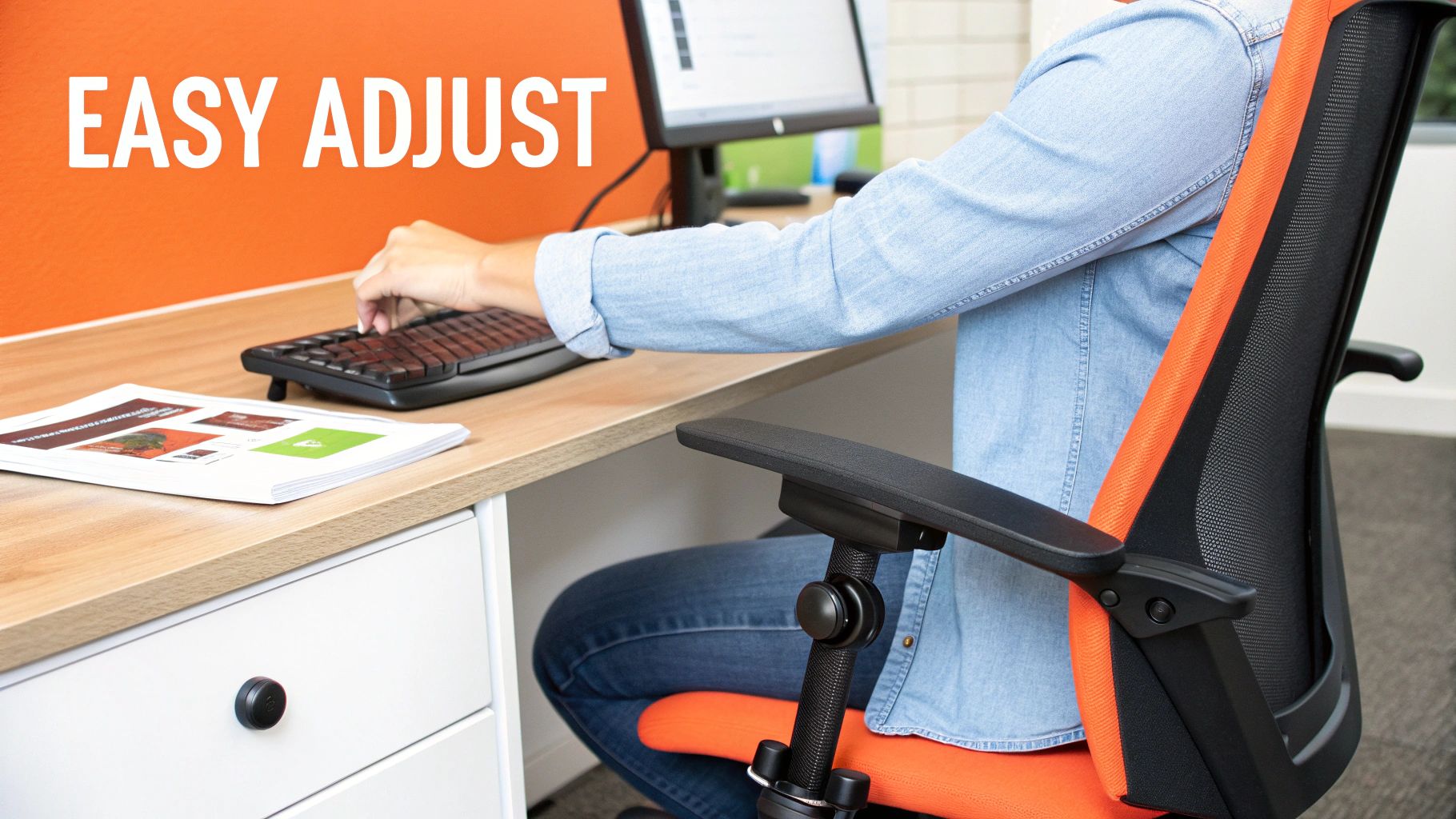
Alright, now that we've covered the essential features, it's time for the fun part: finding the perfect ergonomic chair for you. Think of it like buying a new pair of shoes. It’s a personal decision that needs to fit your body, your daily routine, and your workspace perfectly.
The best place to start is with a little self-reflection. How many hours a day are you really sitting down? What kind of work do you do? A chair that’s fine for someone working four hours a day won't cut it for another person pulling an eight-hour shift with intense, focused tasks.
Matching the Chair to Your Needs
To find your ideal match, you really need to 'test drive' a few options with your own needs front of mind. When you sit in a potential chair, pay close attention to how your body feels. Does the lumbar support actually hit the curve of your lower back? Can you plant your feet flat on the floor with your knees at a comfortable angle?
Here’s what to zero in on:
- Your Body Type: Your height and weight are the most important factors. Taller people often need a deeper seat and a higher backrest. On the other hand, someone more petite needs to be able to lower their chair enough so their feet aren't dangling.
- Your Work Routine: Do you lean forward for close-up, detailed work? A forward-tilt function could be a game-changer. If you’re someone who likes to recline while brainstorming or on calls, make sure the backrest tension feels right—supportive, not flimsy.
- Material and Feel: The material makes a big difference to comfort and temperature. Mesh backs are fantastic for keeping you cool with great airflow. Fabric chairs usually feel softer to the touch and come in a huge range of colours to match your space.
Your perfect chair shouldn't just feel good for five minutes in a store. It should feel like a natural extension of your body, supporting you properly without you even having to think about it.
If you’re looking for a brilliant mix of quality, customisation, and value, the Pago range is a great place to begin your search. A model like the Pago Flash II Deluxe Heavy-Duty Ergonomic Chair is a perfect example of a chair built for long days, offering all the adjustments you need to make it your own. It's a solid investment in your health and wellbeing.
You can explore the whole collection on the Pago website to find a style that suits you, or pop into Officeworks to try them out in person. For an even more detailed walkthrough, don't miss our complete guide on how to choose the right office chair.
Why Ergonomics Matters More Than Ever in Australia
The way we work in Australia has completely transformed. For millions of us, the traditional office is a thing of the past, and the line between our home and our workplace has all but disappeared. This massive shift to desk-based and remote roles means the responsibility for a healthy, supportive workspace now often rests on our own shoulders.
Suddenly, ergonomics isn't just an office buzzword; it's a conversation happening at kitchen tables across the country. When your dining chair becomes your full-time office seat, you quickly realise the physical toll an unsuitable setup can take. We've moved past seeing a good chair as a luxury—it’s now a fundamental necessity.
The Home Office Revolution
This rise in working from home has created a huge, and urgent, demand for proper office furniture. After 2020, the proportion of Australians working from home skyrocketed from just 7% to over 30%. This created a whole new wave of people desperately trying to safeguard their health from the strains of prolonged sitting.
Not surprisingly, ergonomic chair sales in Australia jumped by an estimated 15-20% each year as people scrambled to prevent the aches and pains that were setting in. You can see more on the ergonomic chair market trends at dataintelo.com.
What this really drives home is that an ergonomic chair is an essential tool for the modern professional. Think of it as a proactive investment in your long-term health, helping you stay focused, comfortable, and pain-free for years to come.
For today's Australian worker, an ergonomic chair isn't just another piece of furniture. It’s the very foundation of a sustainable and healthy work life, helping to prevent problems before they even start.
Getting to grips with the benefits of ergonomic office furniture is the first real step in creating a workspace that truly works for you. Investing in a quality chair, like a Pago from Officeworks, gives you the proper support you need, so you can concentrate on your work—not on your aching back.
Your Ergonomic Chair Questions Answered
Making the jump to an ergonomic chair is a fantastic move for your daily comfort and long-term health. But it's completely normal to have a few questions before you dive in. Let's tackle some of the most common ones so you can feel great about your decision.
How Long Does It Take to Get Used to an Ergonomic Chair?
Honestly, you should give yourself a bit of time—anywhere from a few days to a week. Think about it: if you've been slouching in a non-supportive chair for years, your body has actually learned that poor posture. An ergonomic chair nudges you back into a healthier alignment, which can feel a little odd at first while your muscles get reacquainted with proper support.
Don't be shy about fiddling with the settings during that first week. Tiny adjustments can make all the difference in dialling in that perfect fit. The lasting comfort you'll get is more than worth this short break-in period.
Another question we hear all the time is about cost. Does a bigger price tag always mean a better chair?
Not at all. While price can often reflect the quality of materials or the number of fancy features, the best ergonomic chair is always the one that fits your body and your needs.
Does a Higher Price Mean a Better Ergonomic Chair?
A well-made, mid-range chair with the right adjustments for you is a much better investment than a high-end model that doesn't fit your body properly. Instead of getting fixated on the price, focus on the fundamentals: adjustable lumbar support, seat depth and height that you can customise, and armrests that sit just right.
This is where brands like Pago really shine. They deliver these essential features without the eye-watering price tag. A chair like the Pago Flash II Deluxe, for instance, gives you top-tier ergonomic support and durability at a price that makes sense. You can check out the full range at any Officeworks store to see for yourself.
Finally, people often wonder if a new chair is a magic bullet for their aches and pains.
Can an Ergonomic Chair Fix My Existing Back Pain?
An ergonomic chair is a brilliant tool for preventing and easing the kind of back pain that comes from poor posture, but it’s not a medical device. By holding your body in a supported, natural position, it dramatically cuts down on the daily strain on your spine and muscles—which is a huge factor in most workday discomfort.
However, if you're dealing with severe or chronic pain, it's crucial to chat with a doctor or a physio to get a proper diagnosis. The best results always come from a combined approach: a great chair, regular movement breaks, and a few simple stretches. Your chair is a key piece of the puzzle, but creating a healthy workspace around it is just as vital. For more on that, take a look at our complete ergonomic workstation setup checklist to get your entire desk area working for you.


